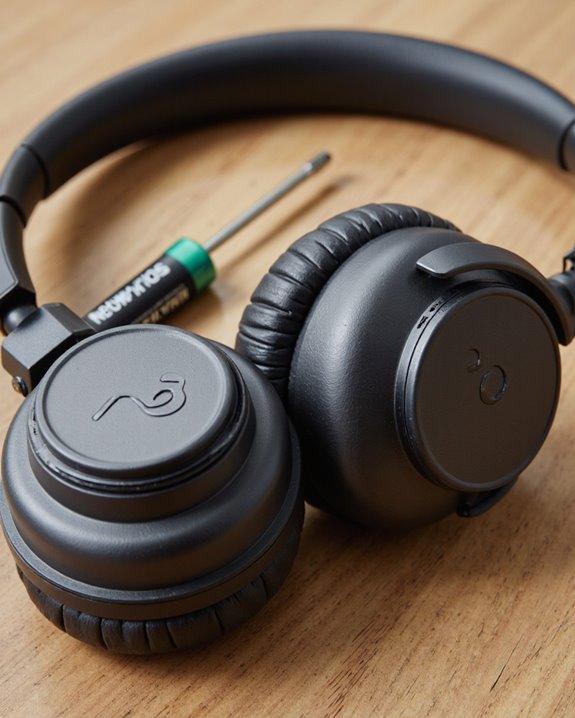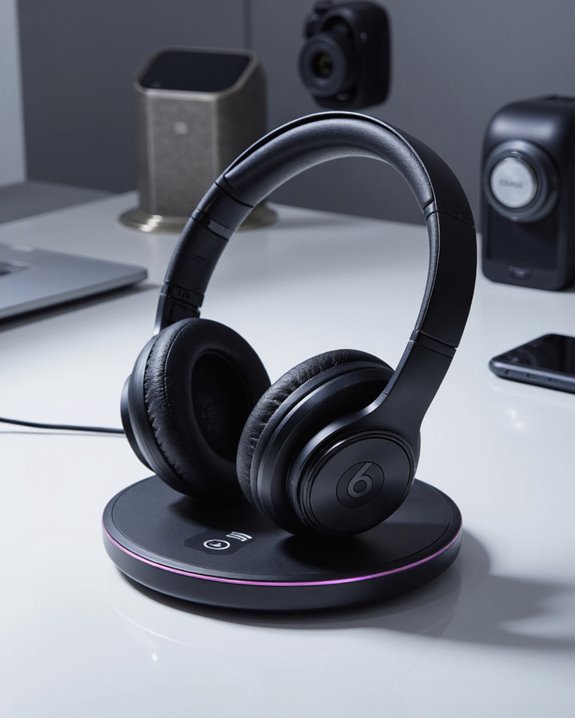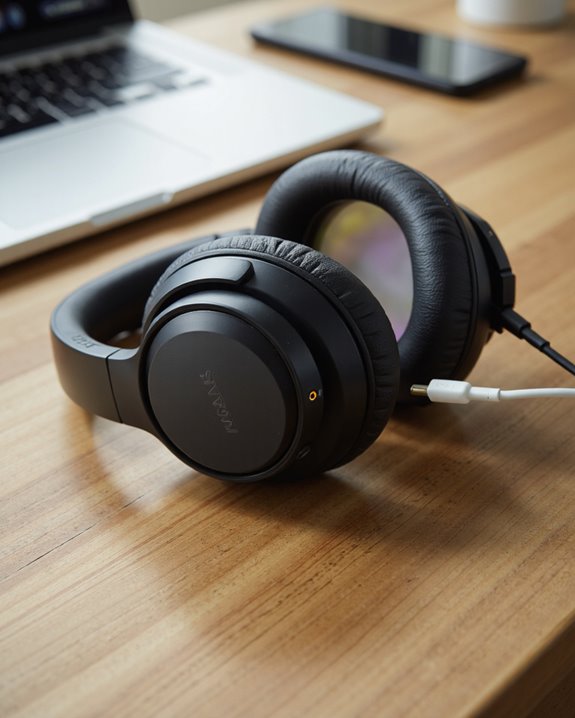As an Amazon Associate, we earn from qualifying purchases. Some links may be affiliate links at no extra cost to you. Although our opinions are based on curated research, we haven't used these products. Articles generated with AI.

Can Headphones Cause Vertigo? Understanding the Risks
Headphones can indeed cause vertigo in some users, especially when worn for extended periods, at high volumes, or when using noise-canceling models. They generate pressure within the ear canal and may overstimulate our vestibular system, leading to dizziness, spinning sensations, or even nausea. People prone to inner ear issues are at higher risk, while open-ear or bone conduction designs may offer relief by reducing ear canal pressure. For more specifics on prevention and safe listening, explore further insights below.
Key Takeaways
- Headphones can cause vertigo by creating pressure in the ear canal, especially with prolonged or high-volume use.
- Noise-canceling headphones may increase vertigo risk by removing essential external auditory cues and altering pressure perception.
- Individuals with pre-existing inner ear or vestibular conditions are more susceptible to vertigo from headphone use.
- Symptoms like dizziness, nausea, or ear pressure after using headphones may indicate vestibular system overstimulation.
- Taking regular breaks, keeping volume moderate, and choosing open-back or bone conduction headphones can help prevent vertigo symptoms.
What Is Vertigo and How Does It Affect the Body
Although we often associate dizziness with momentary disorientation, vertigo is a distinct medical condition that directly involves the inner ear’s vestibular system—our body’s primary center for balance. The vestibular system coordinates with our eyes and muscles to maintain equilibrium, relying on intricate structures within the inner ear. When this balance system is disrupted—due to inflammation, infection, or abnormal pressure—vertigo can occur, producing a spinning sensation that may last from seconds to hours. Symptoms commonly include dizziness, unsteadiness, and, in some cases, nausea. While hearing loss or aural pressure might accompany certain inner ear disorders, vertigo’s primary impact is on spatial orientation and stability. Persistent or severe symptoms warrant thorough evaluation, as vertigo can greatly affect daily functioning and overall quality of life.
Exploring the Link Between Headphone Use and Vertigo

When we consider how our daily tech habits impact our health, the relationship between headphone use and vertigo deserves careful attention. Research indicates that headphones can cause vertigo by generating pressure in the ear canal, potentially overstimulating balance receptors and triggering inner ear issues. Particularly, noise-canceling headphones may increase risk by removing external auditory cues essential for spatial orientation. Extended use—especially at high volume levels—exerts cumulative stress on the vestibular system, heightening susceptibility to dizziness, especially in those with pre-existing inner ear conditions. Sensitivity to pressure changes from headphones is a significant factor, underscoring the need for safe listening practices. To help prevent these problems, we should keep volume below 60% of maximum and take breaks during prolonged listening sessions, supporting overall ear health and reducing vertigo risk.
How Headphones Impact the Inner Ear and Balance
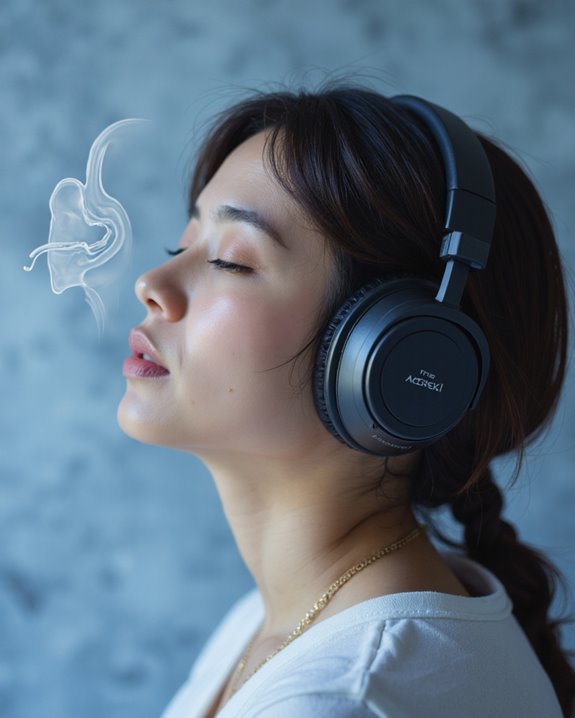
Because headphones interact directly with the ear canal, they can markedly influence the delicate mechanisms responsible for both hearing and balance. When we use headphones that create a tight seal, they alter ear canal pressure—sometimes enough to impact the inner ear’s balance system. The inner ear houses both the cochlea (for hearing) and the vestibular system (for balance), both highly sensitive to changes in sound pressure and vibration. High sound pressure levels, especially during prolonged use, can overstimulate these structures, occasionally resulting in vertigo or dizziness. Those of us with pre-existing inner ear conditions may notice these effects more readily. Understanding how headphones manipulate ear canal pressure and sound delivery helps us make informed choices about safe listening habits and protect our balance and hearing.
Common Symptoms Associated With Headphone-Induced Vertigo

Many of us have experienced brief moments of dizziness or imbalance after removing headphones, particularly following long listening sessions or exposure to high volume levels. These symptoms often manifest as a sensation of tilting or swaying, sometimes accompanied by temporary disorientation. For some, prolonged use of headphones leads to a persistent feeling of pressure in the ear, which may signal the onset of vertigo. Heightened sensitivity to spatial audio effects—such as panning or simulated movement—can further exacerbate these sensations, increasing the risk of experiencing vertigo. Over time, individuals may notice that discomfort and auditory sensitivity develop gradually, especially with elevated sound pressure levels. Collectively, these symptoms highlight the importance of monitoring our headphone use to minimize potential risks to our balance and ear health.
Factors That Increase the Risk of Dizziness From Headphones
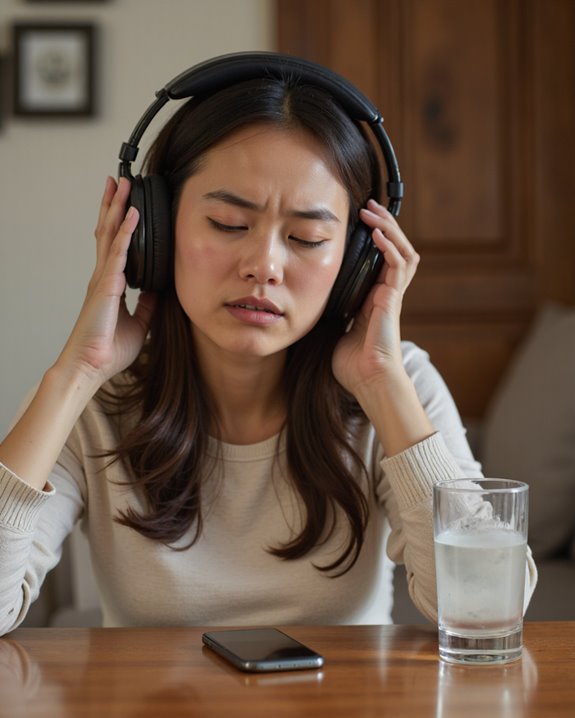
Although listening to music through headphones seems harmless, several key factors can greatly elevate our risk of experiencing dizziness or vertigo. Let’s examine the most significant risk factors. First, prolonged use of headphones—especially in noisy environments—can overstimulate the vestibular system in our inner ears, making us more susceptible to vertigo. Individuals with pre-existing inner ear conditions, such as superior canal dehiscence syndrome, face an even higher risk. High volumes, particularly above 85 dB, are known to disrupt the sacculocollic reflex, which is essential for maintaining balance, further contributing to dizziness. Additionally, noise-canceling headphones may cause disorientation by altering auditory input and producing unnatural ear canal pressure. Finally, those prone to motion sickness often find their symptoms worsened by certain headphone types, particularly active noise-canceling models.
The Role of Volume and Listening Duration in Vertigo Risk

When we consider how headphones might trigger dizziness or vertigo, the volume level and length of listening sessions stand out as significant contributors. Exposure to sound above 85 dB can damage inner ear structures, directly increasing vertigo risk. Excessive use—especially sessions that exceed recommended listening duration—may cause auditory fatigue, leaving us more susceptible to dizziness and disorientation. To maintain a safe level, experts recommend following the 60/60 rule: listen at no more than 60% volume for 60 minutes, then take a 30-minute break. Monitoring our headphone use and adjusting both volume and listening duration can minimize overstimulation of the inner ear reflexes, thereby reducing vertigo risk and supporting long-term auditory health.
Noise-Cancelling Headphones: Are They More Likely to Trigger Vertigo
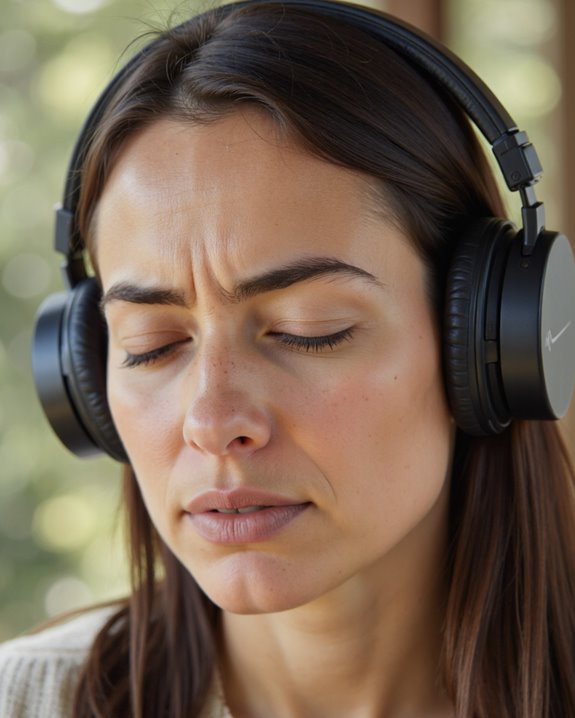
Because noise-cancelling headphones actively reduce external sound by generating anti-phase audio signals, they create a unique acoustic environment that can influence our sense of balance. For those of us sensitive to pressure changes, this technology may disrupt the vestibular system—the inner ear structure responsible for balance—by altering auditory cues and generating a subtle, pressure-like sensation in the ear canal. Blocking ambient noise, especially during prolonged use, can sometimes cause disorientation or even vertigo, particularly if we’re already prone to motion sickness or inner ear issues. The American Journal of Otolaryngology has detailed instances linking noise-cancelling headphones to severe vertigo symptoms, reinforcing these concerns. While most users tolerate them well, individuals sensitive to these effects might consider alternatives like open-back headphones for a more natural listening experience. Models such as the Upgrade Pro utilize hybrid ANC technology, which offers superior noise reduction but may increase the likelihood of such effects due to its active noise cancellation features.
Preventative Measures to Reduce Dizziness While Using Headphones

Since headphone-induced vertigo can disrupt our daily routines, it’s essential to practice a few preventative measures to safeguard our balance and auditory health. First, let’s take regular breaks—removing headphones every hour allows our inner ear to recalibrate, reducing the risk of overstimulation. We should keep the volume at or below 60% of the maximum; excessive loudness can strain the inner ear, affecting both hearing and balance. Over-ear headphones or open-back designs might better disperse sound pressure, minimizing pressure changes that could trigger discomfort. If we’re sensitive to pressure changes, avoiding active noise-cancelling headphones is advisable. Always monitor how our bodies respond—if dizziness occurs, remove the headphones promptly and consult a healthcare professional if symptoms persist. These steps help maintain safe listening habits. Choosing headphones with memory foam padding can also enhance comfort and reduce pressure that might contribute to dizziness during extended use.
How Open-Ear and Bone Conduction Headphones May Help

Beyond adopting smart listening habits, choosing the right headphone design can further reduce vertigo risks. Open-ear headphones, by allowing ambient sound to enter freely, decrease ear canal pressure and help us maintain spatial awareness—key factors in minimizing dizziness. Bone conduction headphones take a different approach: they transmit audio through the skull bones, bypassing the eardrum and inner ear structures that may be sensitive to pressure changes. This technology often results in less discomfort during prolonged use, which many users find beneficial for ear health. Both open-ear and bone conduction headphones also reduce the likelihood of excessive earwax buildup, a contributor to balance issues. Studies show that these designs can provide a more natural listening experience, supporting both our comfort and equilibrium.
Best Practices for Safe and Comfortable Headphone Listening
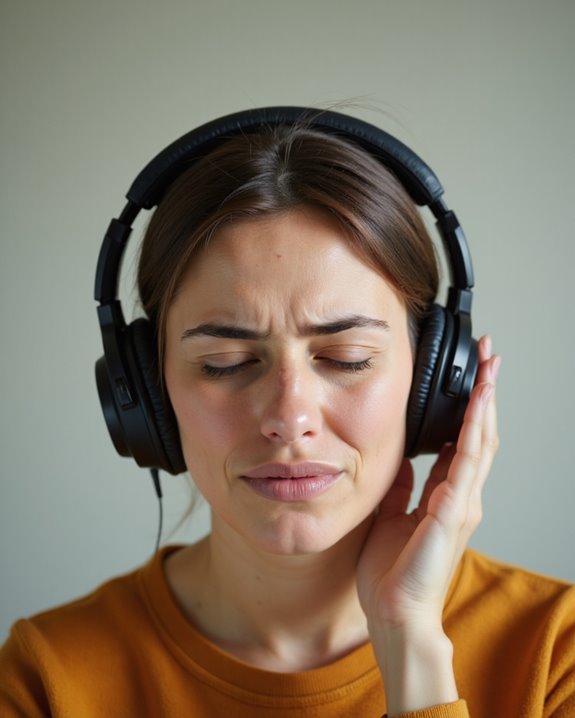
Although headphones have become an essential part of our daily routines, it’s important to adopt safe listening practices to prevent discomfort and reduce vertigo risks. To protect our inner ears, we should limit headphone use to short sessions—ideally, no more than 60 minutes at a time—followed by regular breaks. Keep the listening time at a safe volume, generally below 60% of the maximum, to minimize pressure on the ear and avoid unnecessary discomfort. Selecting open-back headphones can reduce ear canal pressure, which may lower the risk of dizziness associated with prolonged use. Also, ascertain the fit isn’t too tight, as excessive pressure can affect our sense of balance. If dizziness or discomfort occurs, stop using headphones and seek medical advice. Choosing headphones with noise-cancelling microphone capabilities can also enhance comfort by reducing environmental distractions and the need to increase volume.
Frequently Asked Questions
Can Headphones Trigger Vertigo?
We’ve all felt like we’re floating in space after marathon listening sessions—headphone design, sound quality, and ear pressure can absolutely trigger balance issues! Prolonged use, intense acoustic effects, and noise cancellation may disrupt spatial awareness, causing vertigo.
What Are the Symptoms of Too Much Headphones Use?
When we use headphones for prolonged exposure, we might notice ear fatigue, increased sound sensitivity, ear pressure, tinnitus symptoms, and even hearing loss. Some of us experience balance issues or higher discomfort levels, signaling it’s time for a break.
Is It Bad to Listen to Headphones All Day?
We shouldn’t listen to headphones all day, as prolonged exposure risks hearing damage, auditory fatigue, and poor ear health. For headphone safety, let’s monitor volume levels, take breaks, and prioritize sound quality over music preferences to protect ourselves.
Can Listening to Music Cause Vertigo?
When we listen to music, especially at high sound pressure or for prolonged exposure, our auditory system can experience balance disruption or music induced vertigo. Let’s protect ear health—frequency sensitivity and acoustic trauma can worsen these effects.


